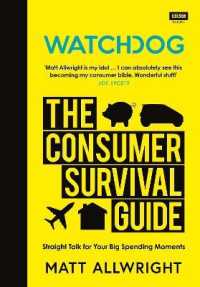- ホーム
- > 洋書
- > 英文書
- > Nature / Ecology
Full Description
Agriculture is the product of a complex mixture of behavioural, biophysical and market drivers. Understanding how these factors interact to produce crops and livestock for food has been the focus of economic investigation for many years. The advent of optimisation algorithms and the exponential growth in computing technology has allowed significant growth in mathematical modelling of the dynamics of agricultural systems. The complexity of approaches has grown in parallel with the availability of data at increasingly finer resolutions. Farm-level models have been widely used in agricultural economic studies to understand how farmers and land owners respond to market and policy levers. This book provides an in-depth description of different methodologies and techniques currently used in farm-level modelling. While giving an overview of the theoretical grounding behind the models, an applied approach is also used. Case studies range from the application of modelling to policy reforms and the subsequent impacts on rural communities and food supply. This book also provides descriptions of the use of farm-level models in much wider fields such as aggregation and linking with sectoral models. Its purpose is to show the reader the methods that have been employed to inform decision-makers about how to improve the economic, social and environmental goals required to achieve the aims of multidimensional policy.
Contents
Part 1: Farm-level Assessments 1: Policy Impact Assessment 2: Positive Mathematical Programming 3: Modelling Farm-level Adaptations Under External Shocks 4: Farm-level Modelling, Risk and Uncertainty 5: Modelling Farm-level Biosecurity Management 6: Modelling Farm Efficiency 7: Quantifying Agricultural Greenhouse Gas Emissions and Identifying Cost-effective Mitigation Measures Part 2: Modelling beyond the farm gate 8: Moving Beyond the Farm: Representing Farms in Regional Modelling 9: Farm-level Microsimulation Models 10: Scaling Up and Out: Agent-Based Modelling to Include Farmer Regimes 11: Catchment-level Modelling 12: Modelling Food Supply Chains 13: Linkage of a Farm Group Model to a Partial Equilibrium Model 14: Conclusions: The State-of-the-art of Farm Modelling and Promising Directions








